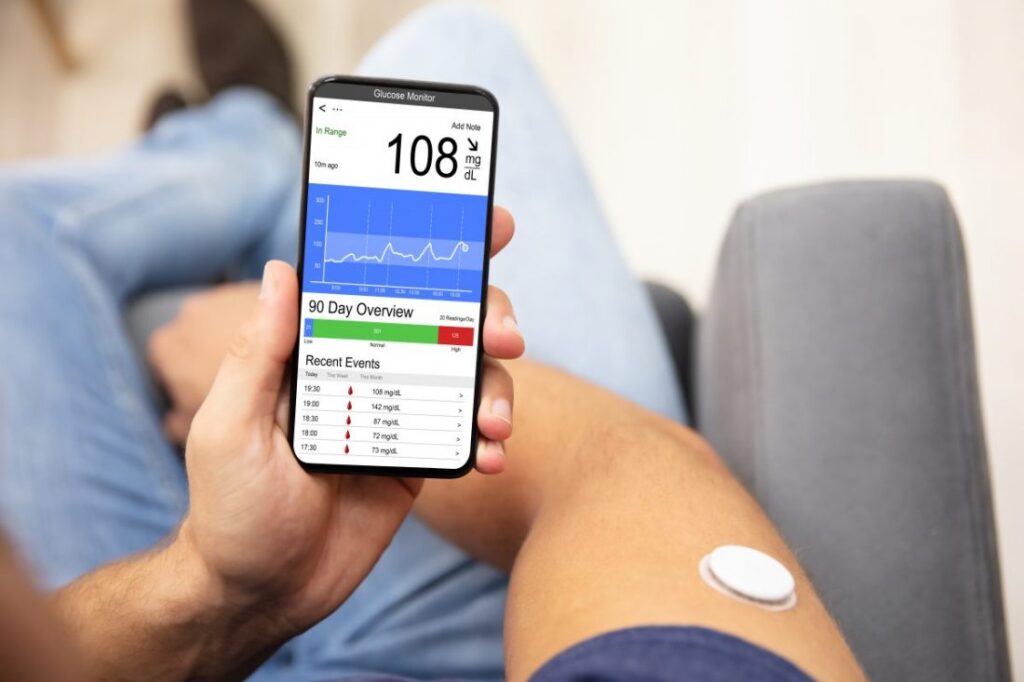he use of Continuous Glucose Monitoring (CGM) systems has transformed the way people manage their diabetes by giving them real-time access to blood glucose levels. Unlike conventional fingerstick methods, Continuous Glucose Monitors or CGMs provide continuous data, enabling people to make informed decisions about their diet, exercise routine, and medication. Nevertheless, as with any medical technology, there are potential risks and side effects associated with CGMs, which this article explores to give readers a thorough understanding of the implications of using CGM systems.
How Continuous Glucose Monitors Work
An under-the-skin sensor, a transmitter connected to the sensor, and a receiver or compatible smart device that shows the glucose data are the standard components of a CGM system. Every few minutes, the transmitter transmits data to the receiver about the glucose levels that the sensor has measured in the interstitial fluid, or the fluid that lies between the cells. This constant information flow makes it easier to spot patterns and trends in blood glucose levels, which improves diabetes care.
Typical CGM Side Effects
Skin Irritation and Allergic Reactions
Skin-related problems are the most often reported side effects associated with the usage of Continuous Glucose Monitors or CGMs. The glue used to affix the sensor may result in rash, itching, redness, or irritation of the skin. Users may occasionally experience adverse reactions to the adhesive or sensor material, which might result in contact dermatitis.
Pain and Discomfort
Some users may experience pain or discomfort when the sensor is inserted beneath the skin. This part of using a CGM might be difficult for people with sensitive skin or low pain thresholds, even though the pain is usually minimal and transient.
Infection
An infection can result from any skin break. Localized infections at the sensor site are uncommon, but they might occur as a result of inadequate cleanliness or incorrect insertion procedures. An infection manifests as redness, swelling, warmth, and pus production.
Sensor Error
Despite being sophisticated technology, Continuous Glucose Monitors or CGMs can malfunction. Owing to calibration mistakes, improper placement of the sensor, or individual variability in interstitial fluid glucose levels, sensors can occasionally produce erroneous readings. The user’s health may be at risk when inaccurate readings result in treatment decisions that are not acceptable.
Behavioral and Psychological Risks
Anxiety and Overload of Data
Some individuals may find the continuous barrage of data from a CGM to be too much to handle. Anxiety and tension might be brought on by the strain to maintain ideal glucose levels and the worry about hypo- or hyperglycemia. This can be a big disadvantage for people who are easily fixated on their health information.
A Misplaced Feeling of Safety
There is a risk of false security when relying only on CGM data without cross-checking with conventional blood glucose monitoring. Users may overlook other crucial facets of diabetes care, such routine blood tests, diet, and exercise, if the CGM readings are off.
Explore More A Comprehensive Guide to Continuous Glucose Monitors vs. Flash Glucose Monitors
Risks and Considerations for the Long Run
Skin Injury
Skin injury can result from long-term CGM use, particularly if sensors are often put in the same location. This may show up as scar tissue, which could impede sensor performance in the future and raise the possibility of infection.
The Price and Availability
Although not a physical side effect, there can be serious concerns about the accessibility and expense of CGMs. Because Continuous Glucose Monitors or CGMs are costly, not all insurance companies will pay for them in full. The cost burden may cause inconsistent use, which could have an impact on diabetes management as a whole.
Dependency on Technology
Over-dependence on technology has pros and cons. Although Continuous Glucose Monitors or CGMs offer useful data, conventional diabetes care techniques should still be used in addition to CGMs. To prevent becoming overly dependent on CGM devices, users need to be informed about their limitations and risk for error.
Reducing the Hazards
Correct Sensor Insertion and Maintenance: You can reduce the chance of skin irritation, infection, and malfunction by according to the manufacturer’s instructions for sensor insertion and maintenance. Reducing skin responses can be achieved by using skin barrier wipes or hypoallergenic adhesives.
Frequent Cross-Verification and Calibration
Modern Continuous Glucose Monitors or CGMs require very little calibration; however, cross-checking CGM results with conventional blood glucose meters on a regular basis is crucial. This procedure guarantees that any disparities are found and fixed right away.
Instruction and Assistance
It is essential to have sufficient training on the use of Continuous Glucose Monitors or CGMs and comprehending the data they offer. Healthcare practitioners should ensure that users are properly trained, supported, and equipped to manage the device. They should also address any issues that may arise.
Psychological Assistance
Psychological support and therapy can be helpful for users who are stressed out or anxious as a result of continuous monitoring. Anxiety can be reduced by learning how to analyze data without undue stress and by realizing that sporadic swings are typical.
In summary
With features including trend analysis, real-time glucose monitoring, and enhanced blood glucose control, continuous glucose monitoring systems are an invaluable tool in the management of diabetes. They do, however, come with risks and adverse effects. Physical dangers include skin irritation, pain, infection, and malfunctioning sensors; psychological and behavioral issues include data overload, anxiety, and technology dependence.
A complete strategy including appropriate sensor use, frequent data cross-verification, education, and psychological support is needed to mitigate these dangers. Users can optimize the advantages of continuous glucose monitoring (CGM) systems and improve their diabetes management approach by comprehending and resolving these possible problems. In the end, even if Continuous Glucose Monitors or CGMs have many benefits, diabetes treatment should be approached holistically, with the goal of empowering people to control their health in a proactive, informed, and aware manner.


